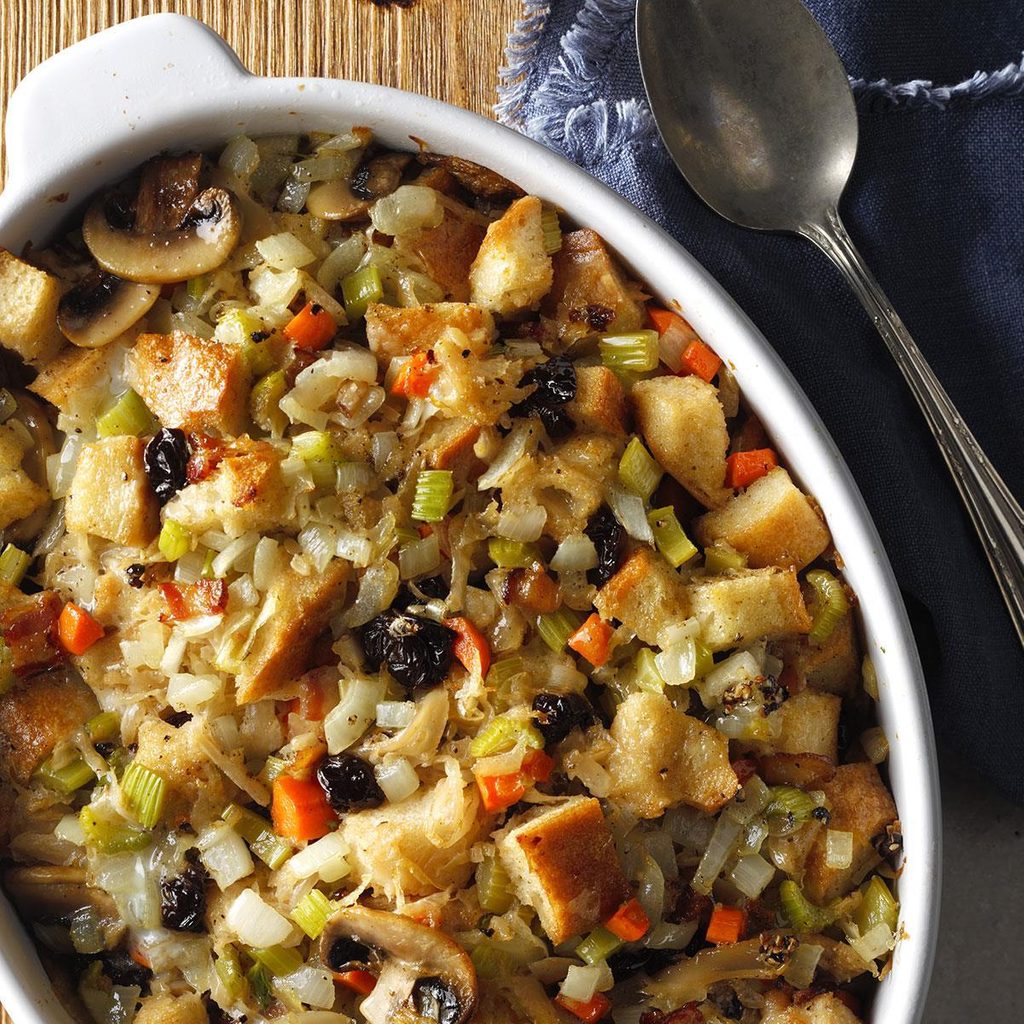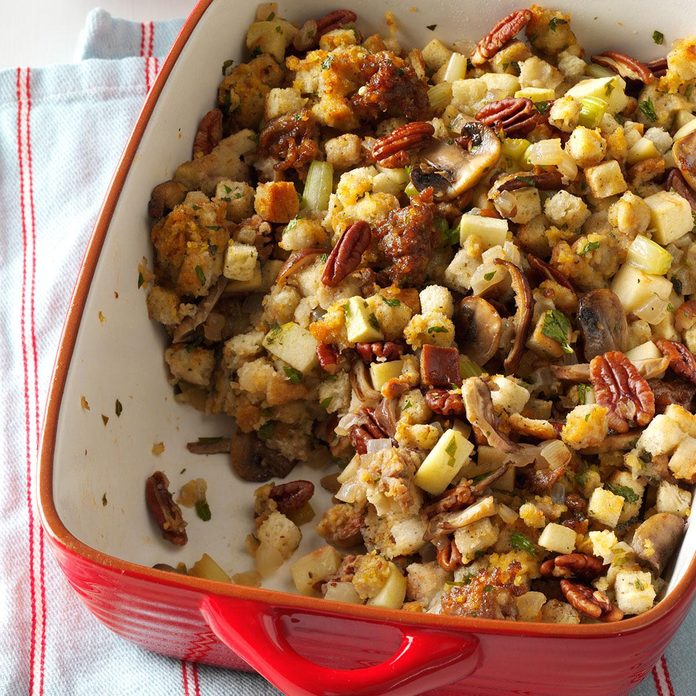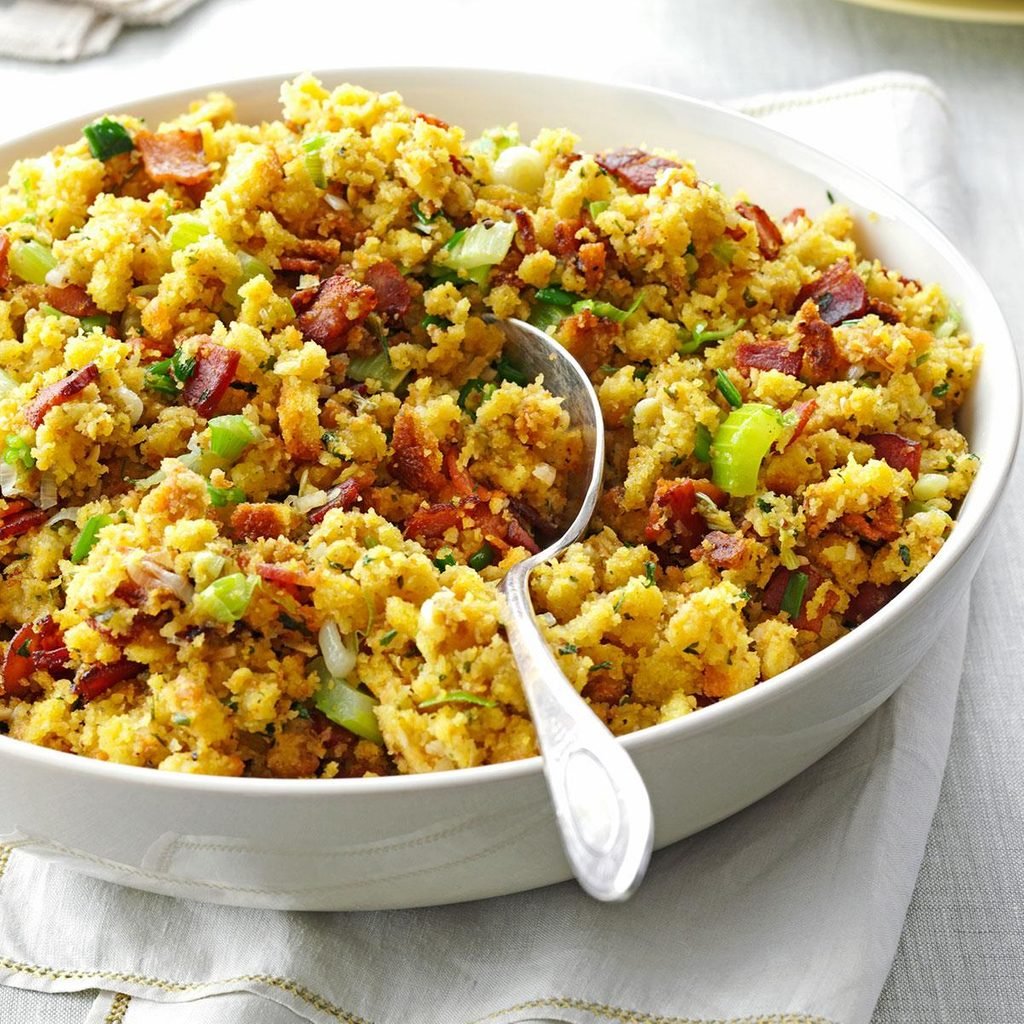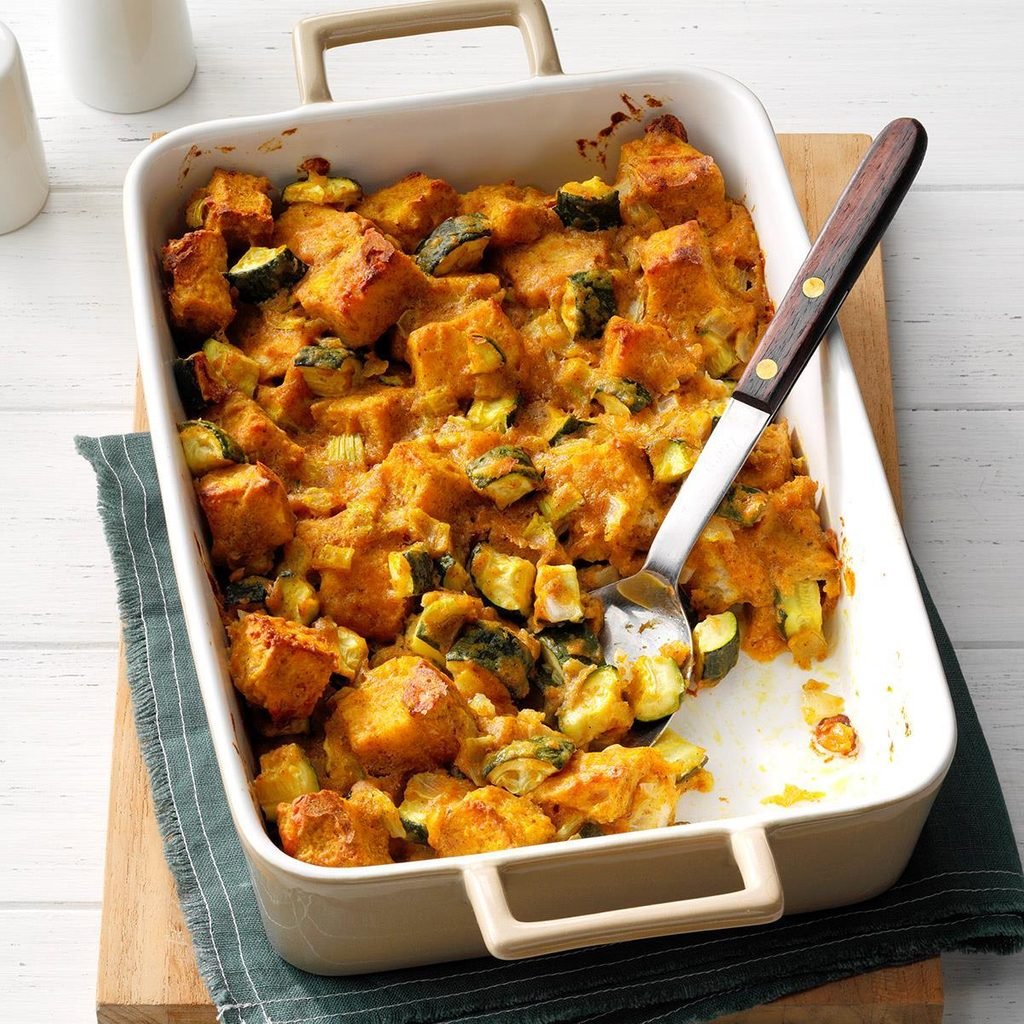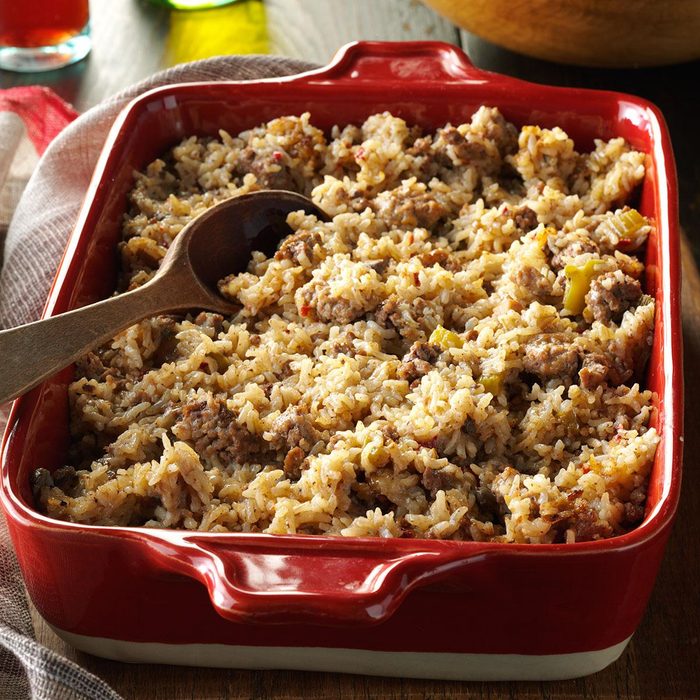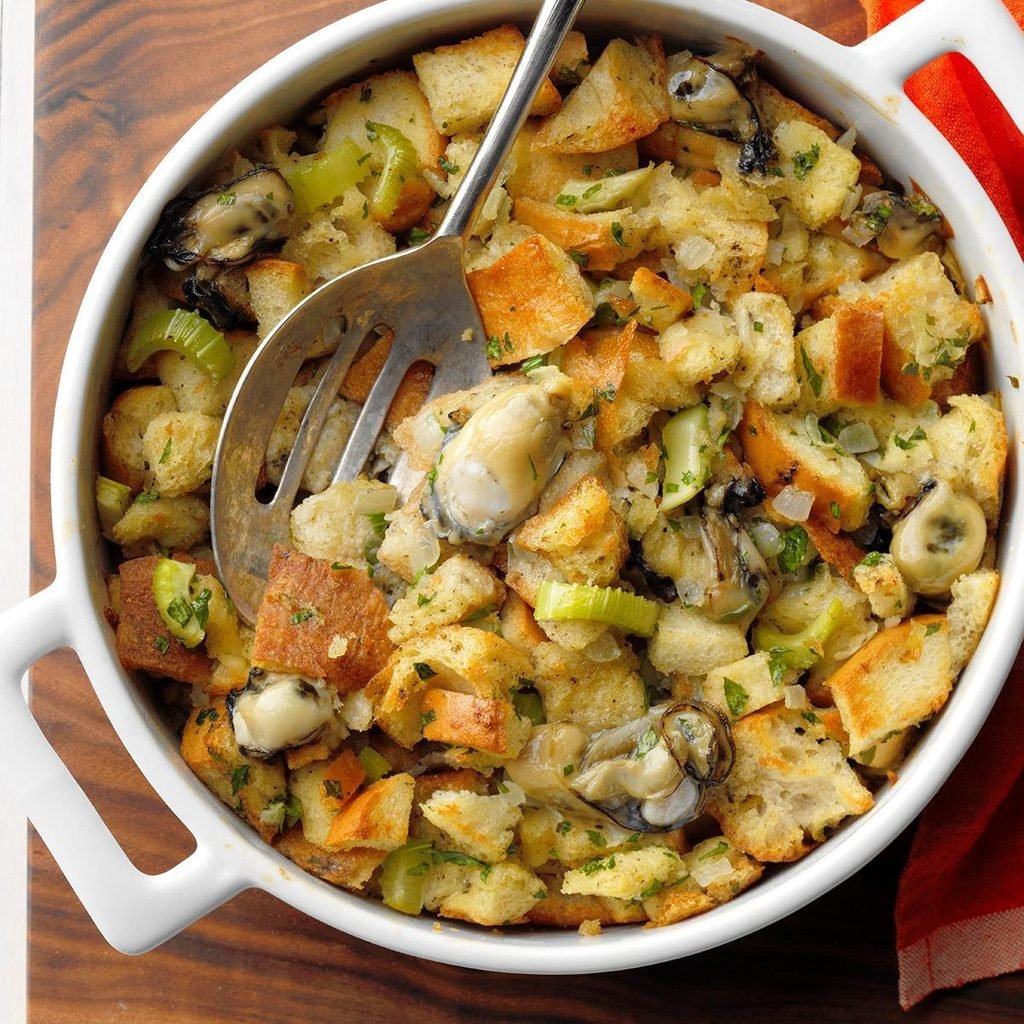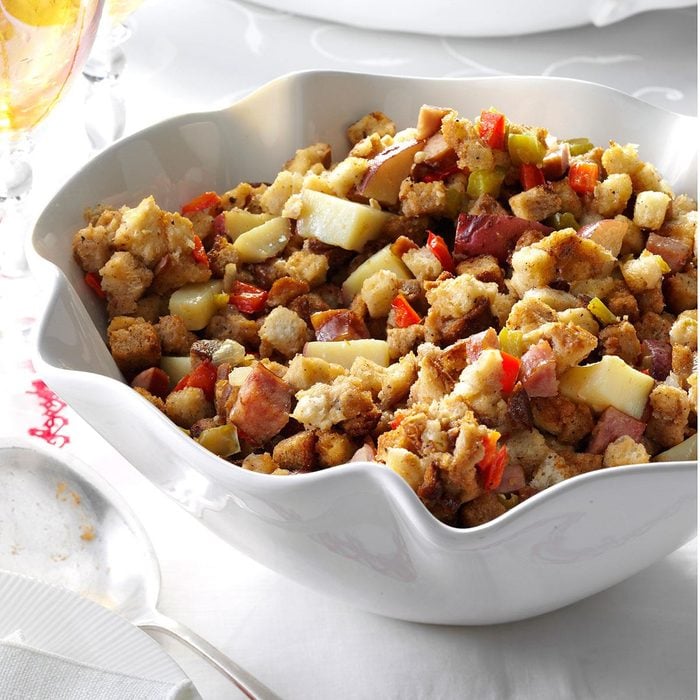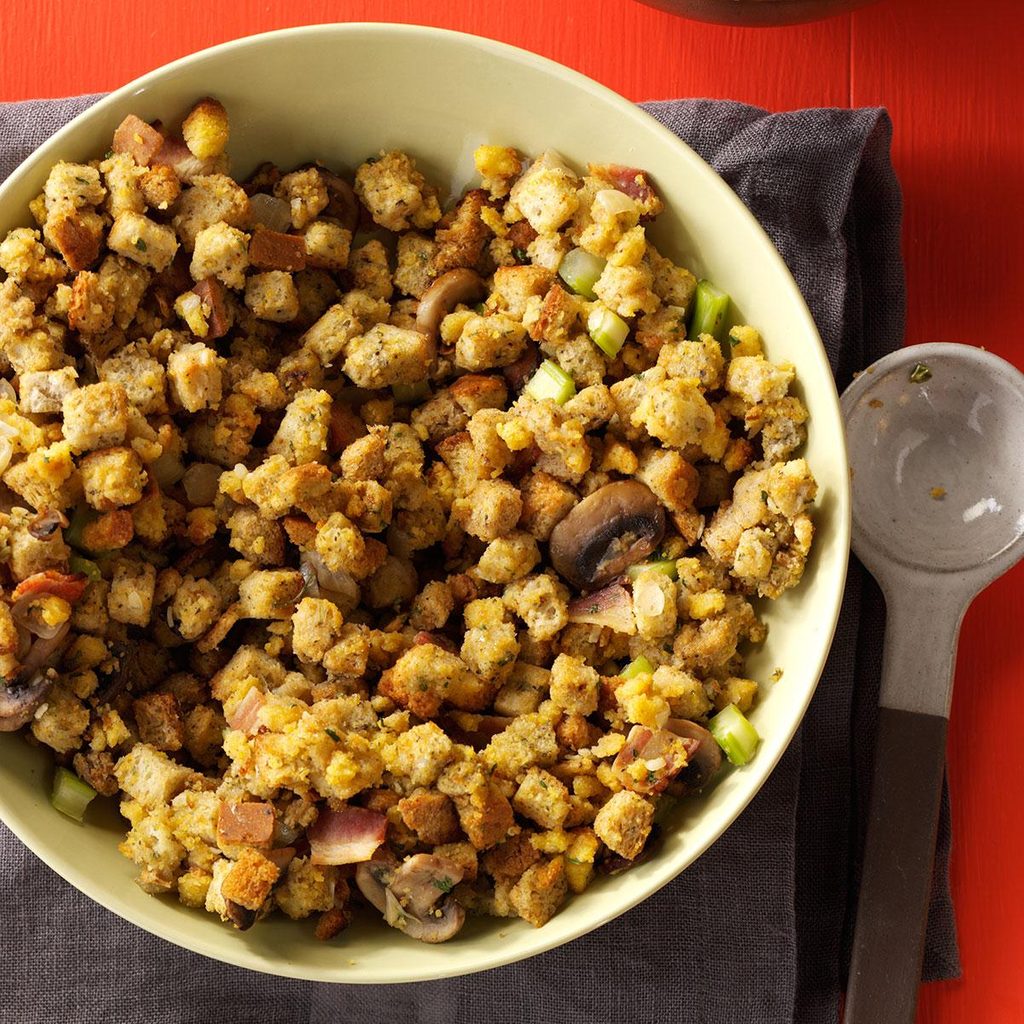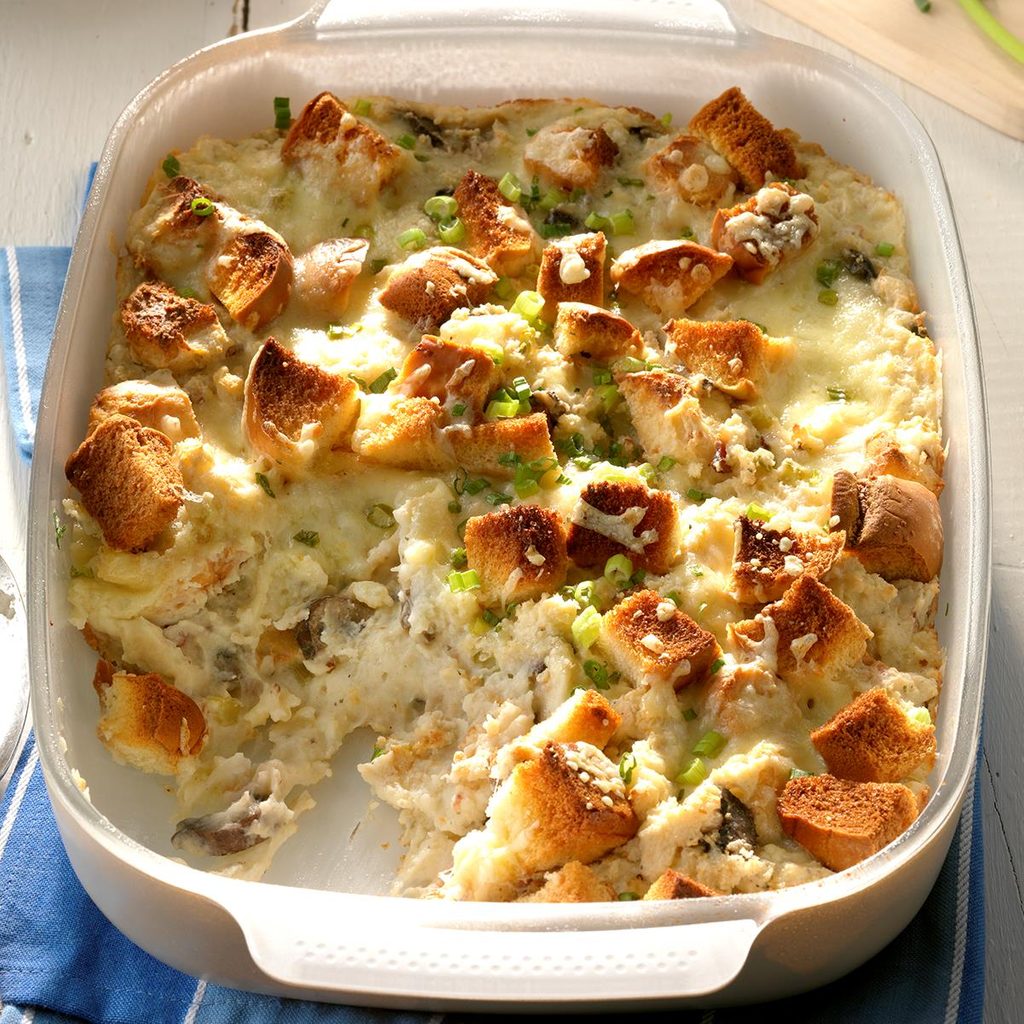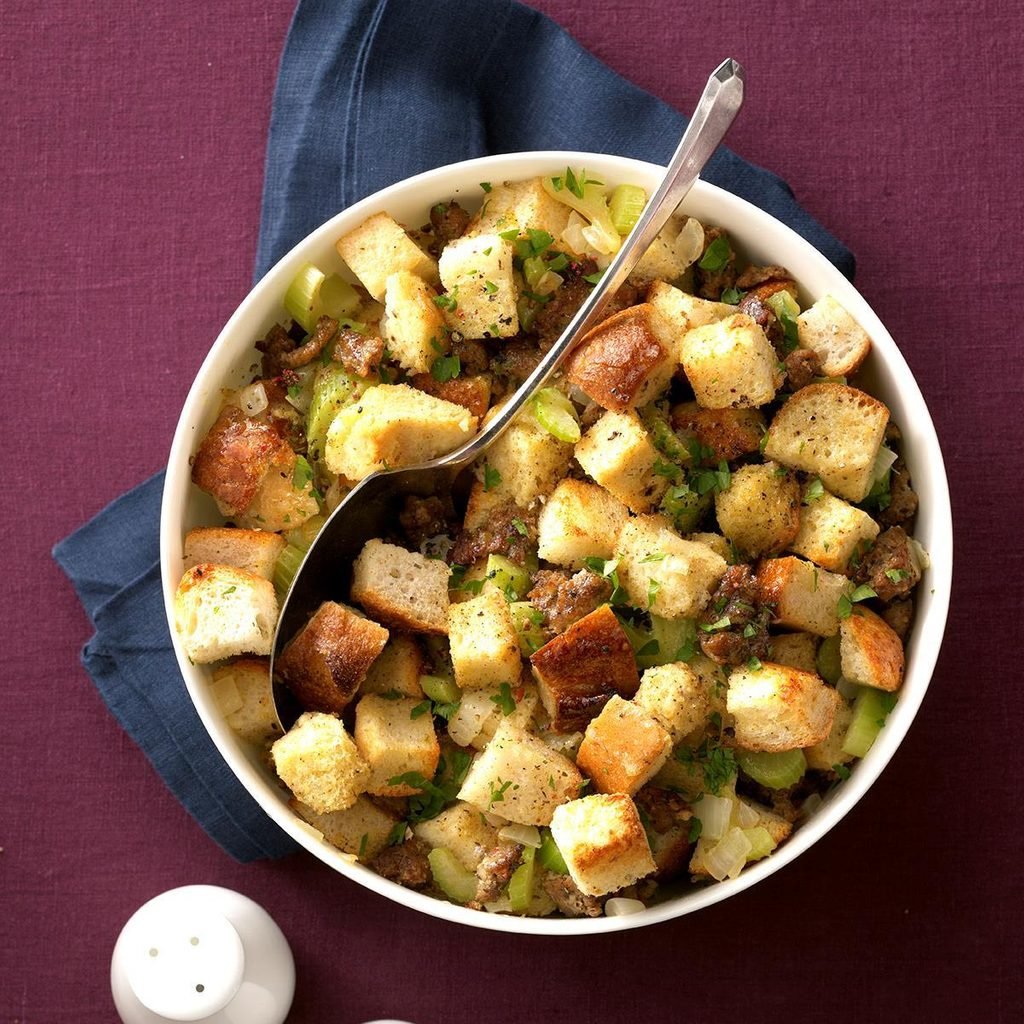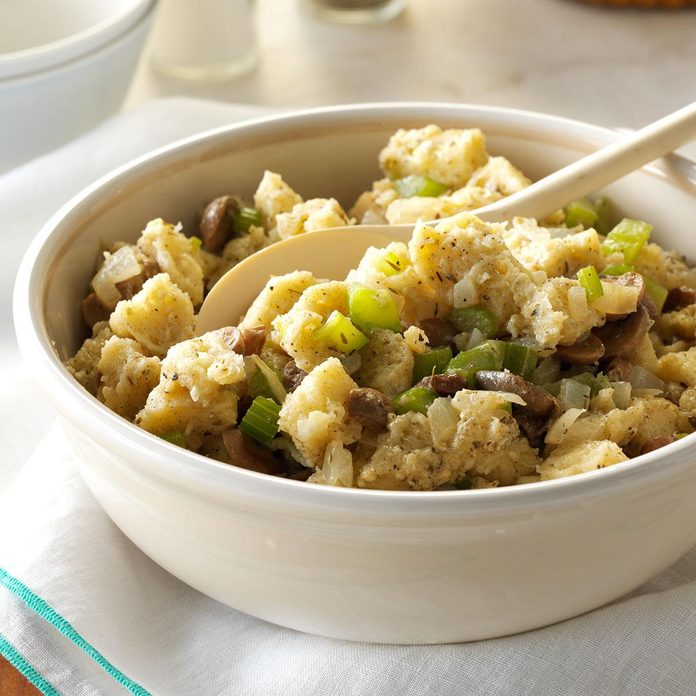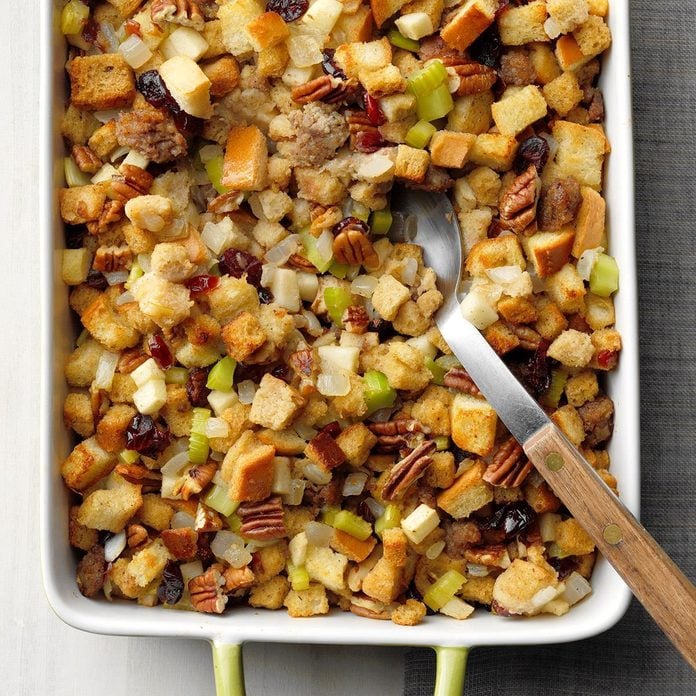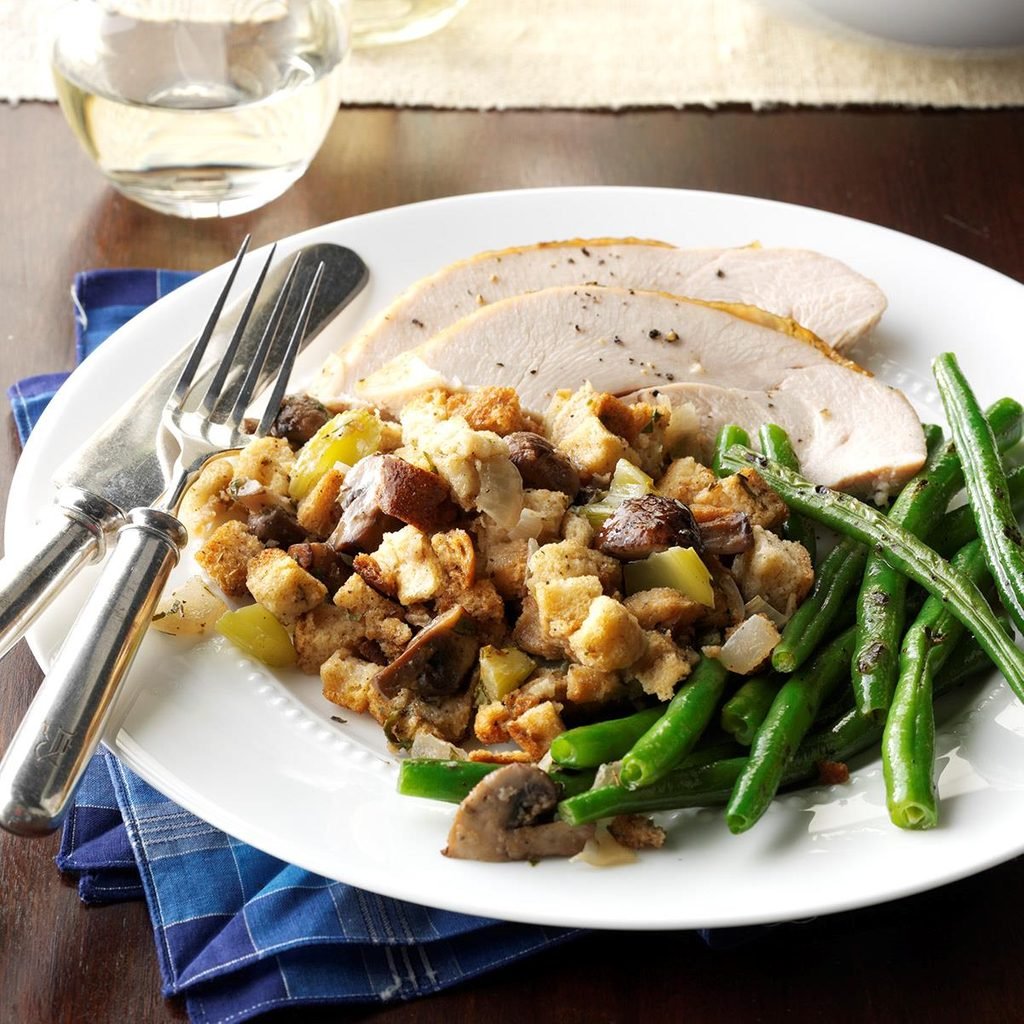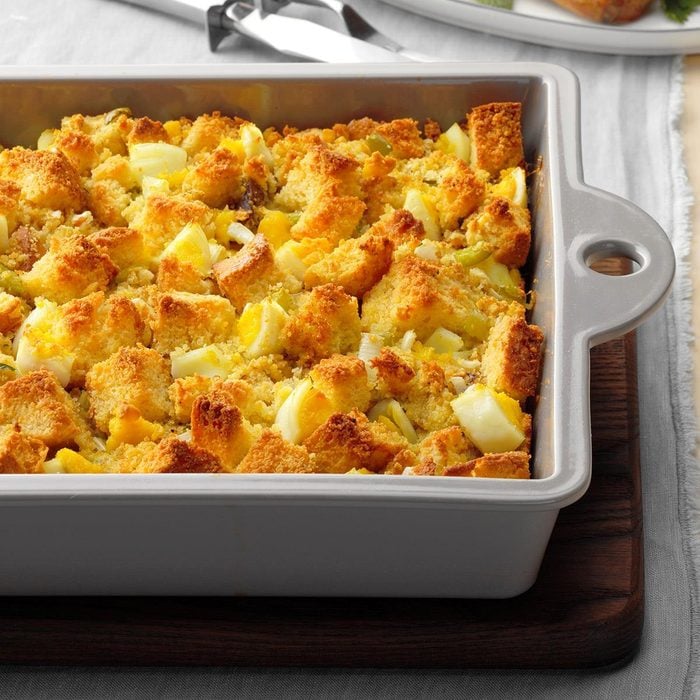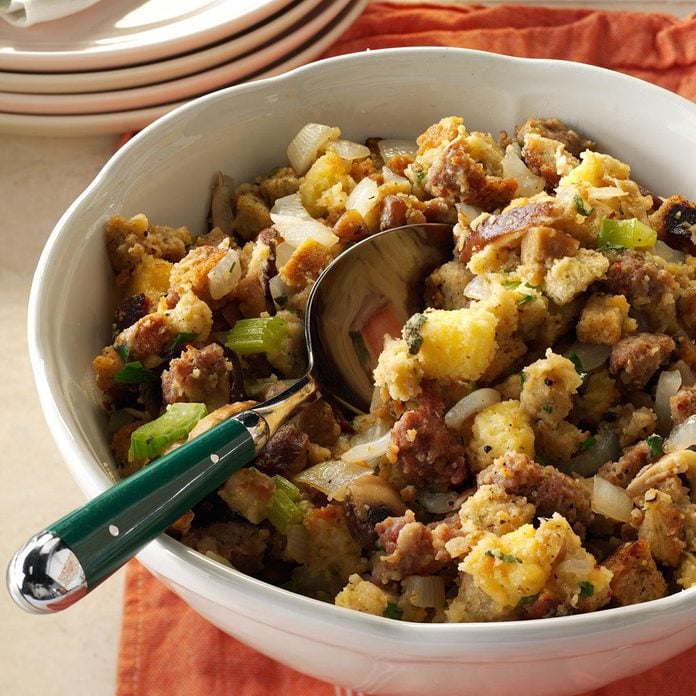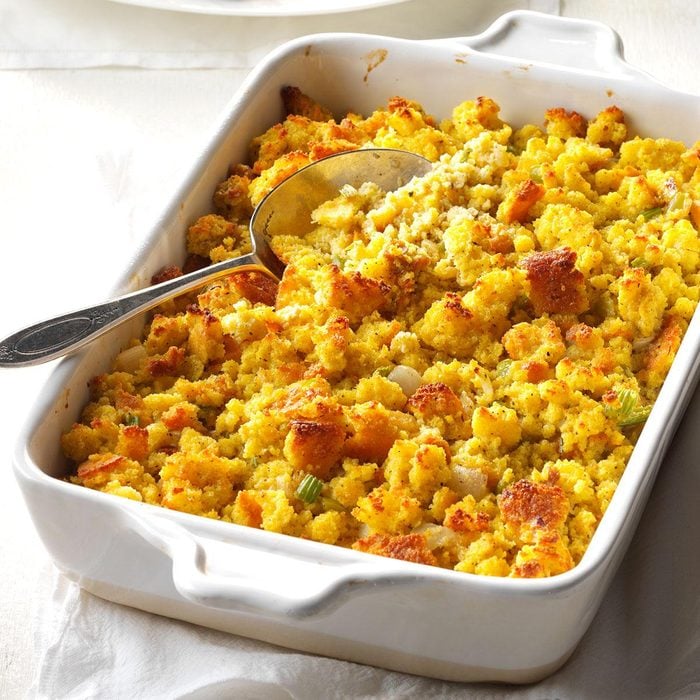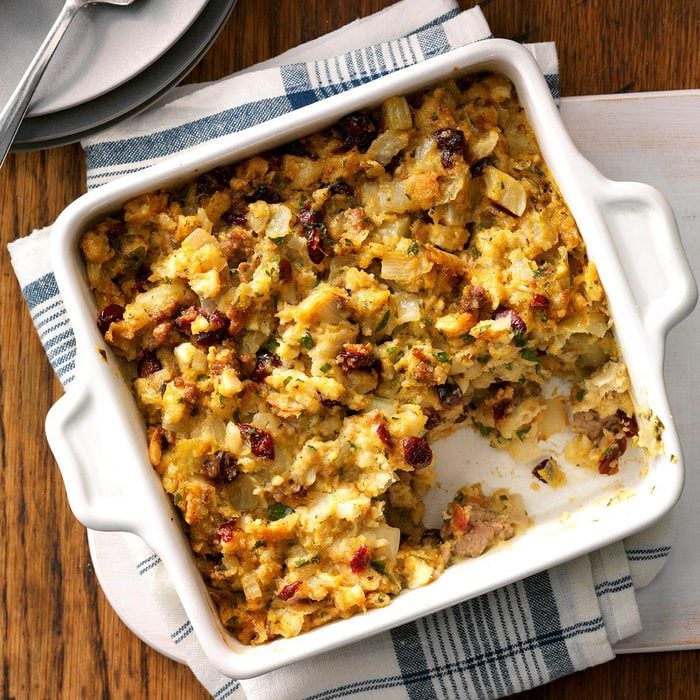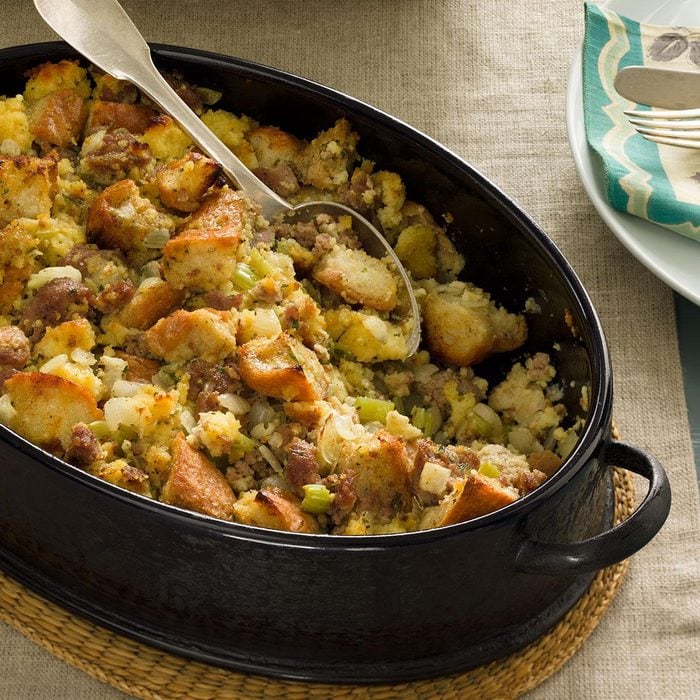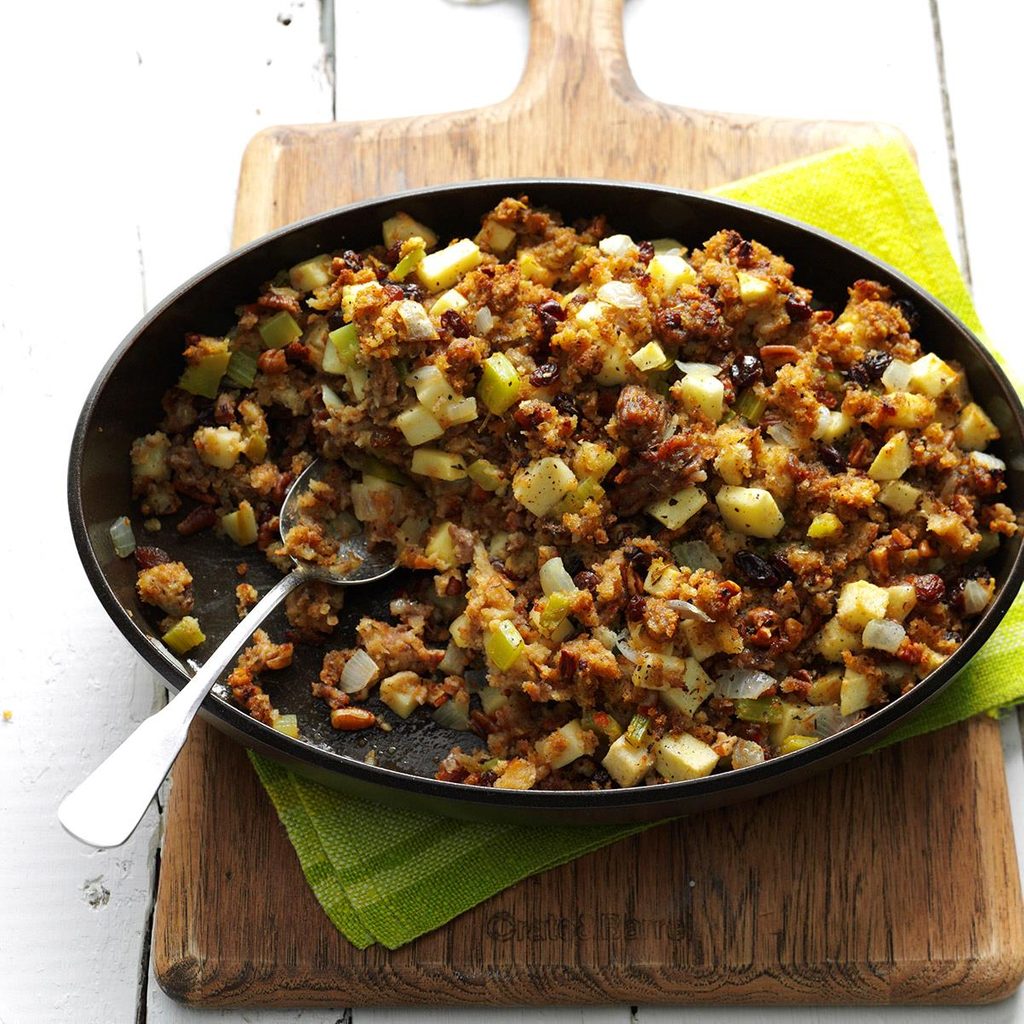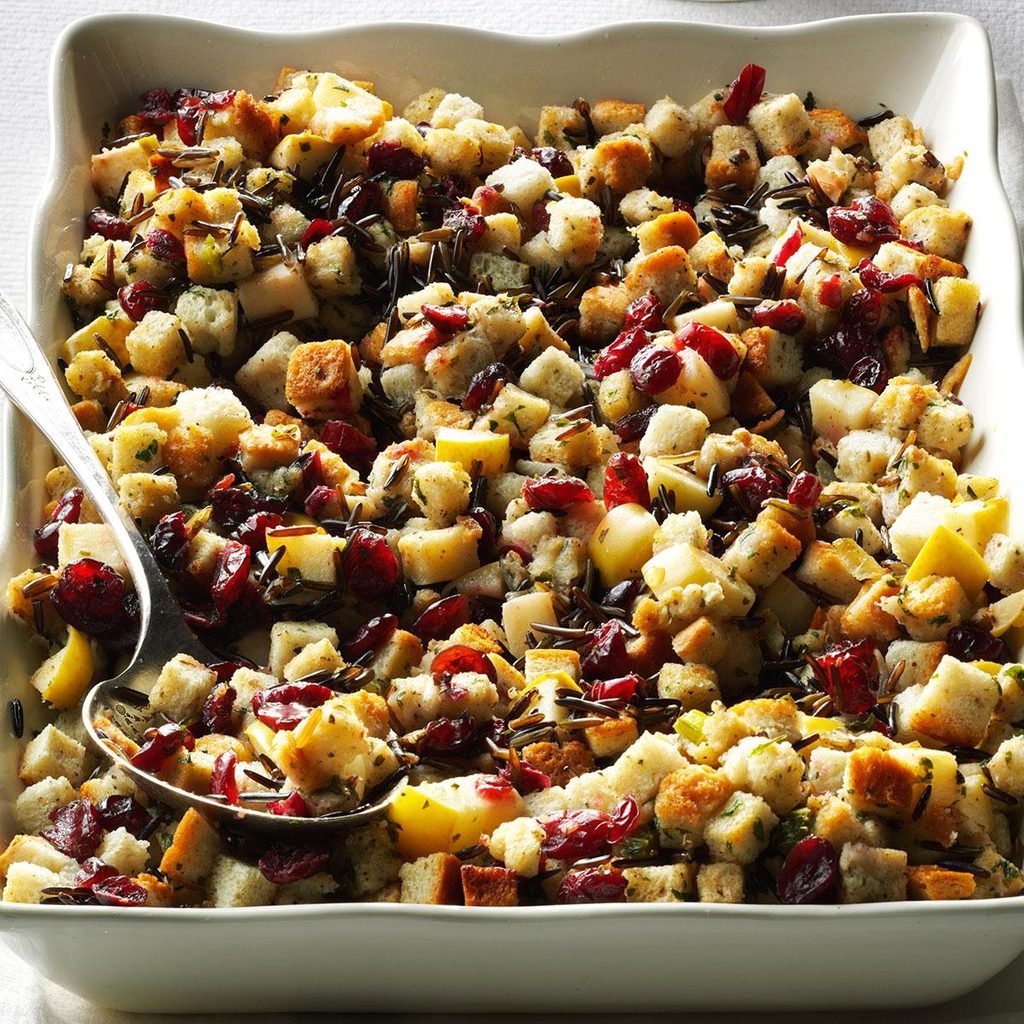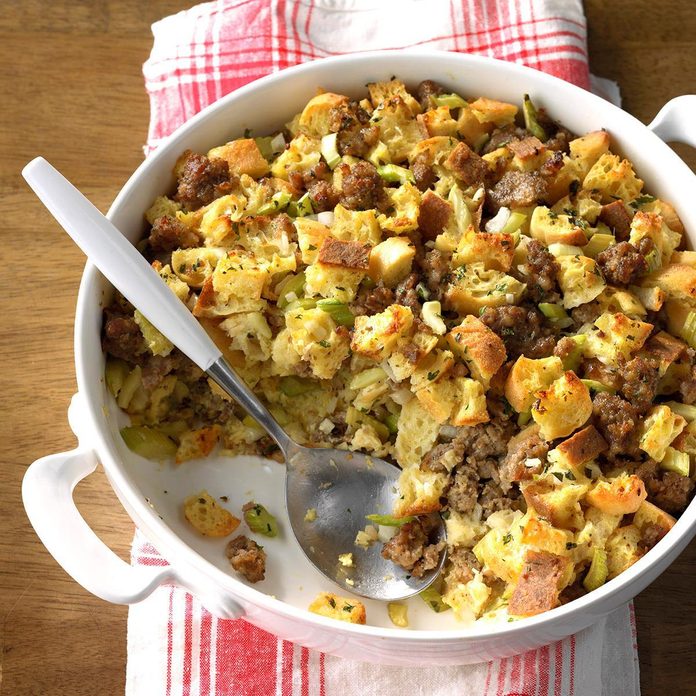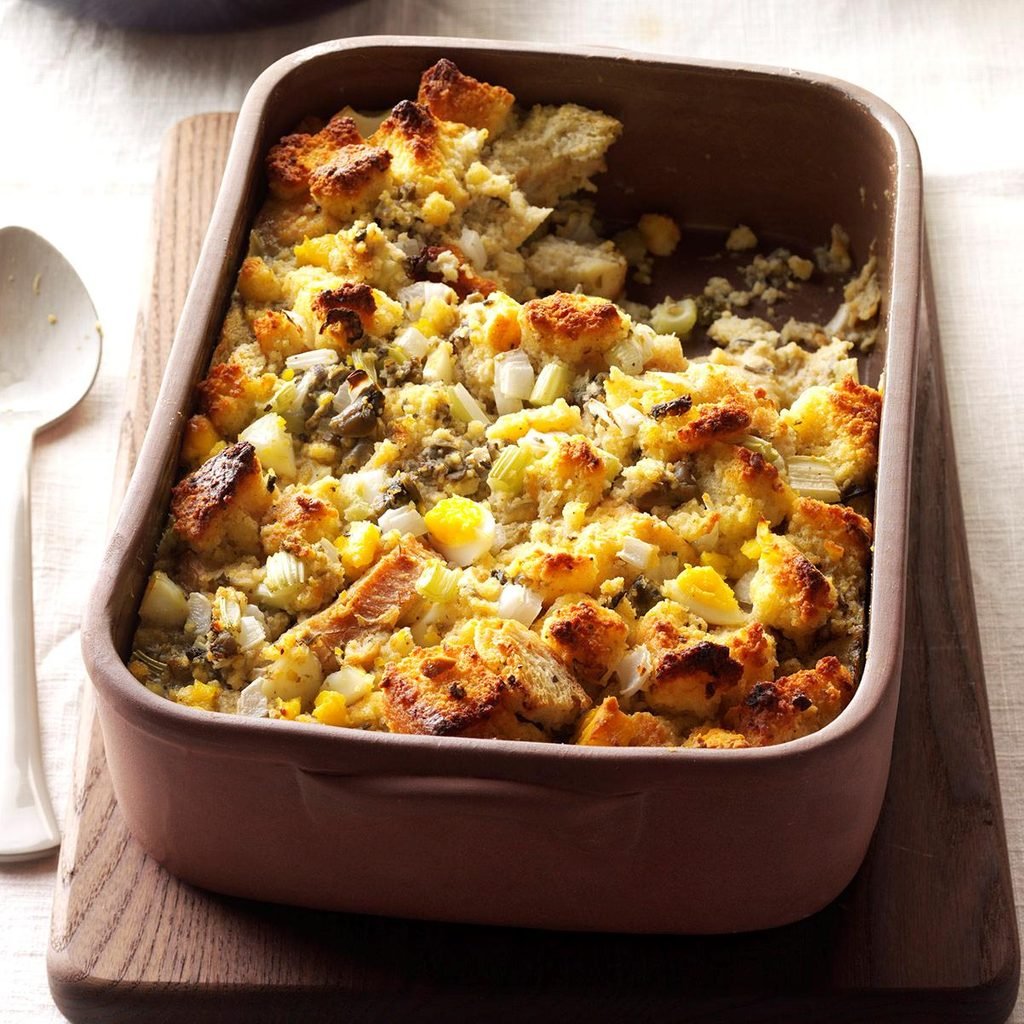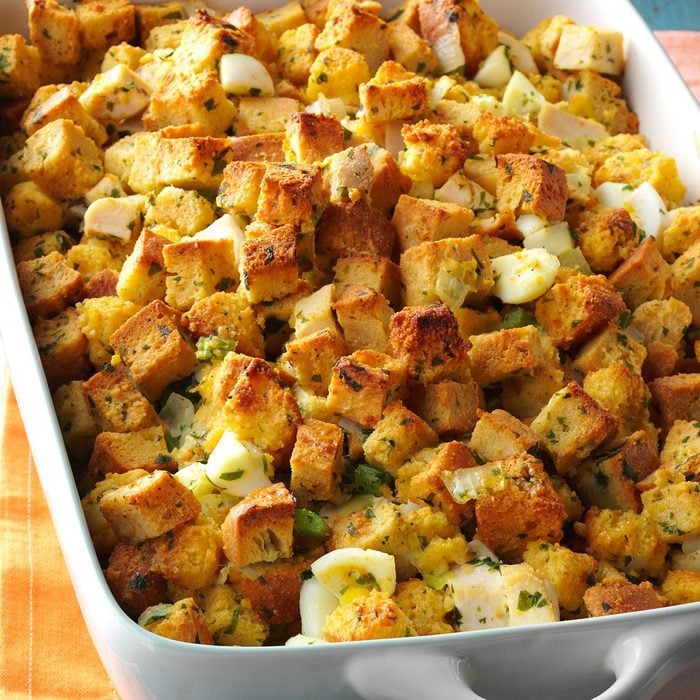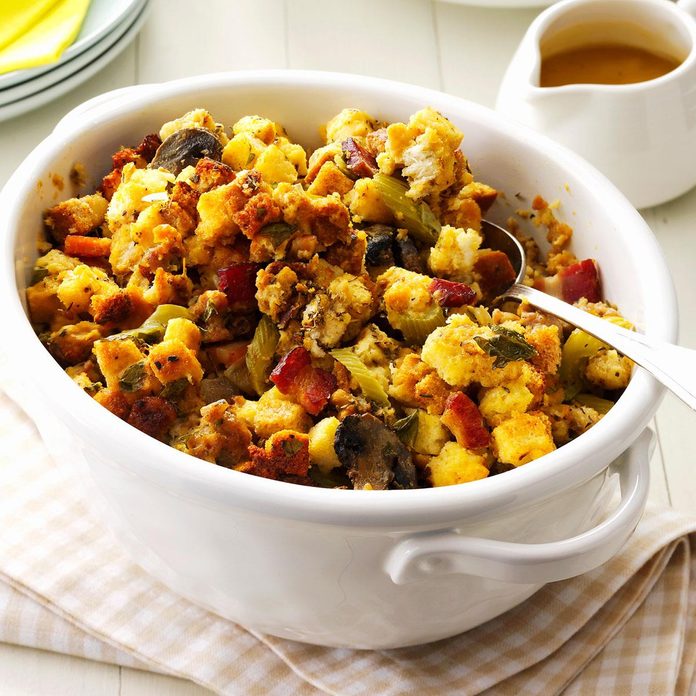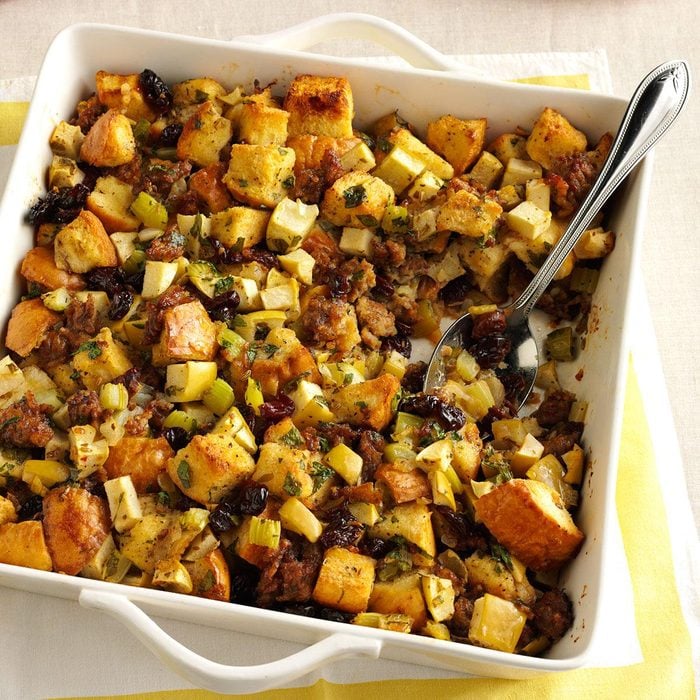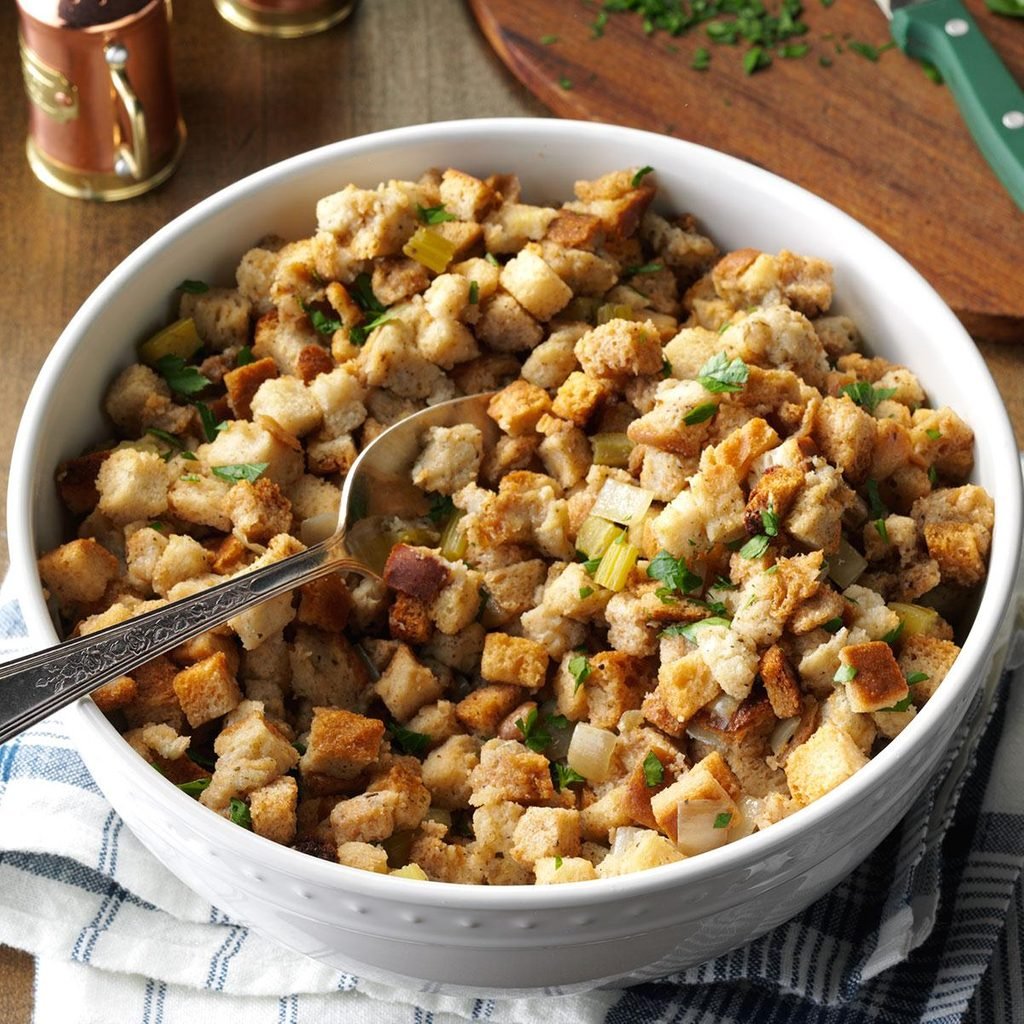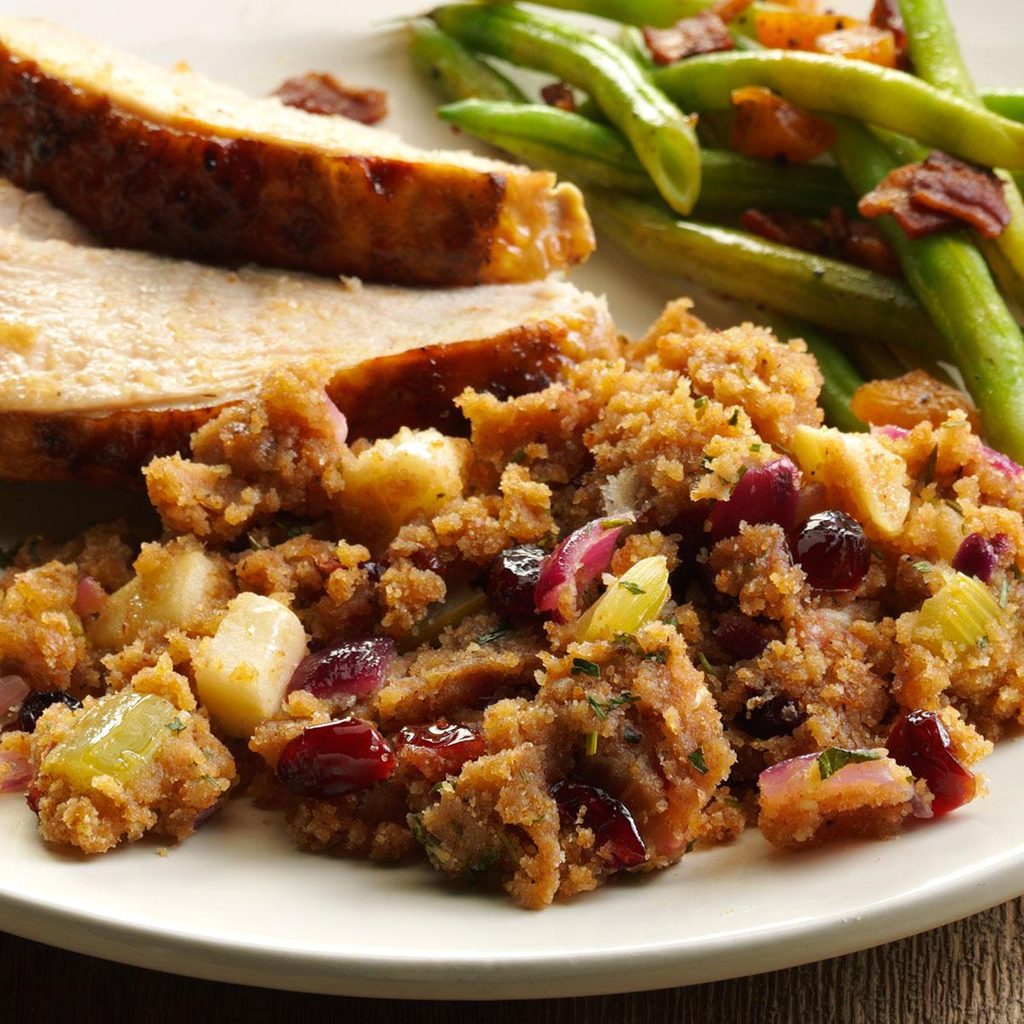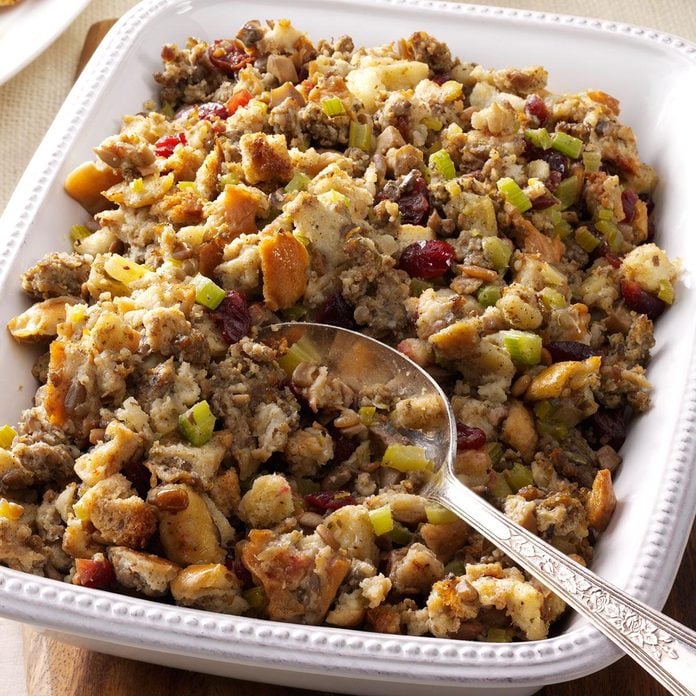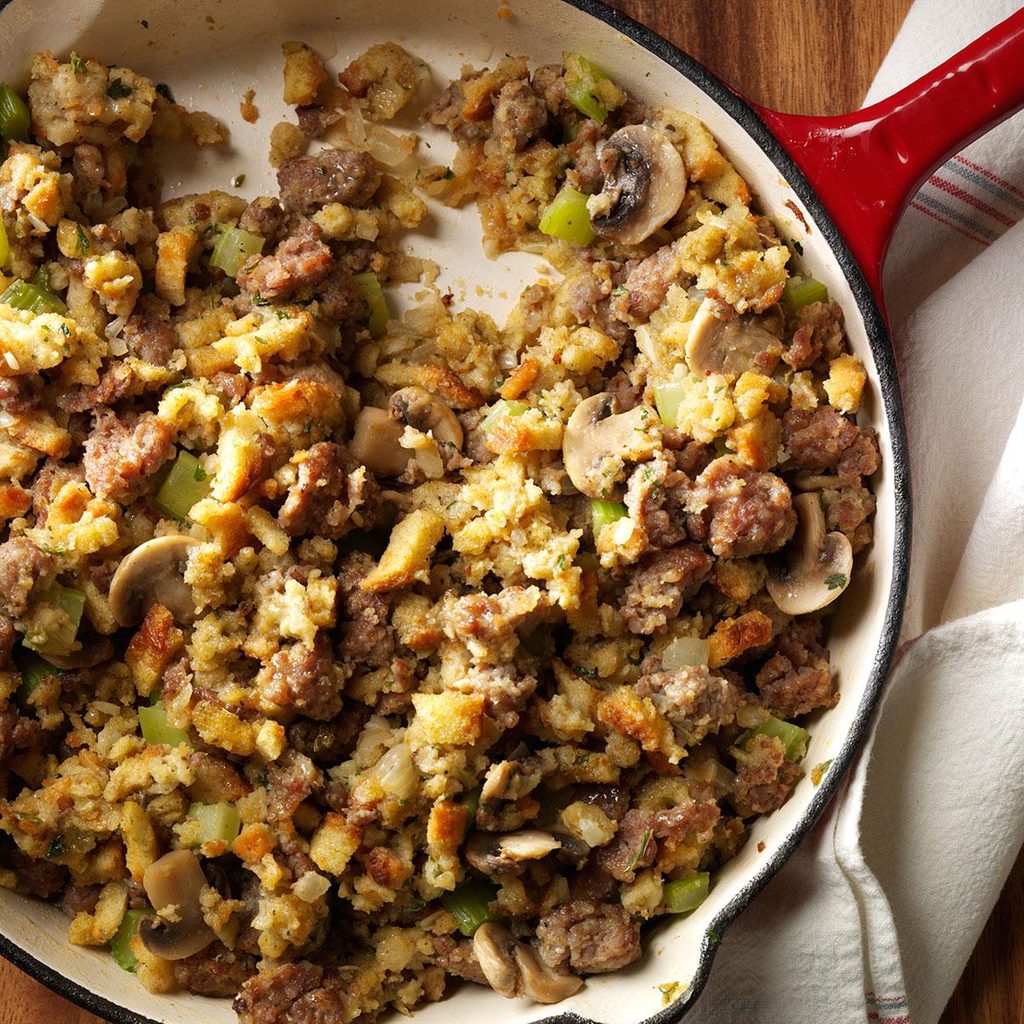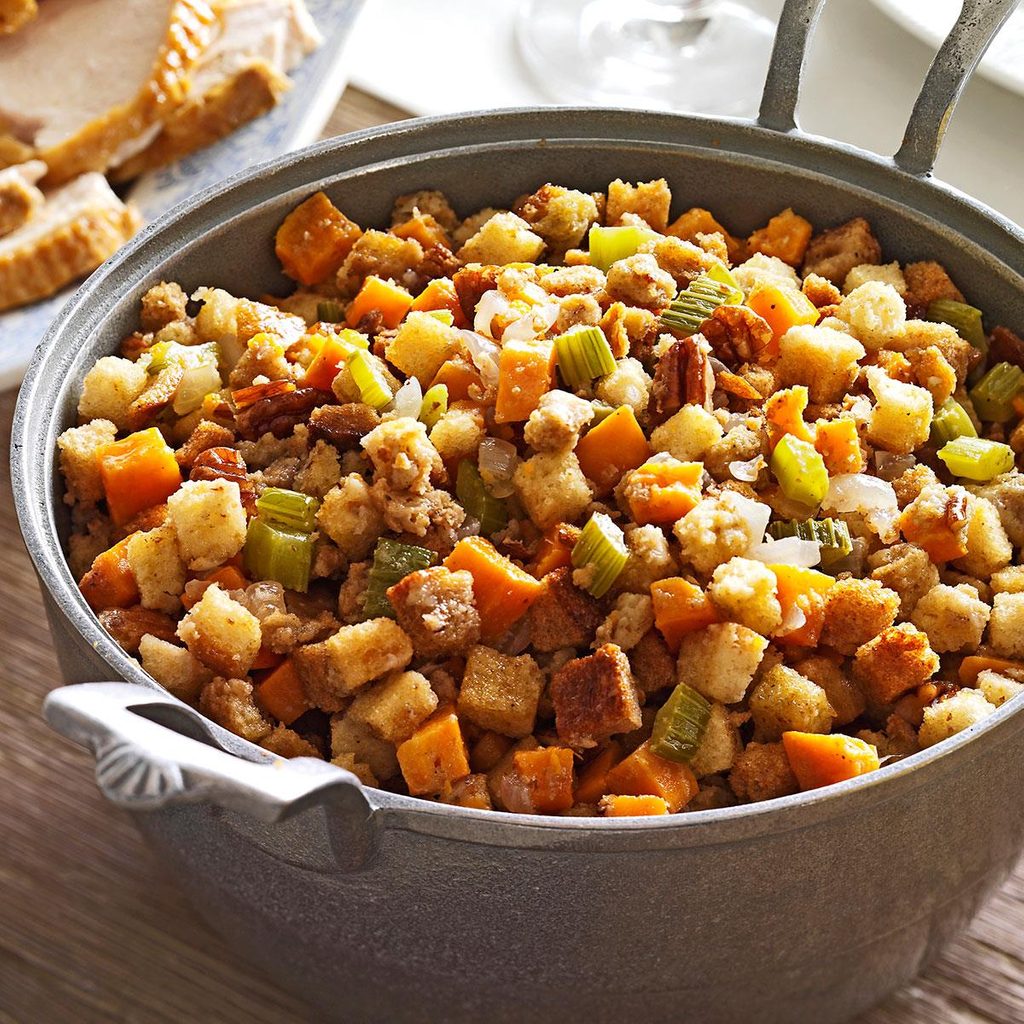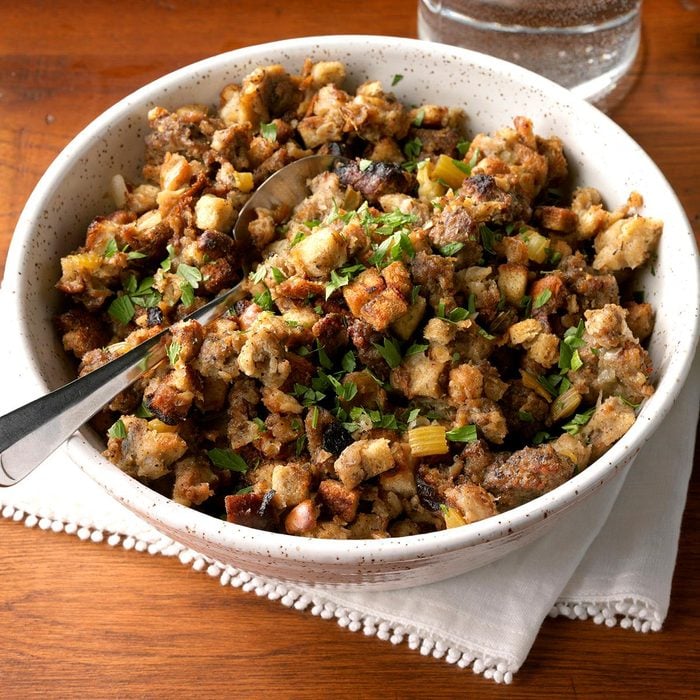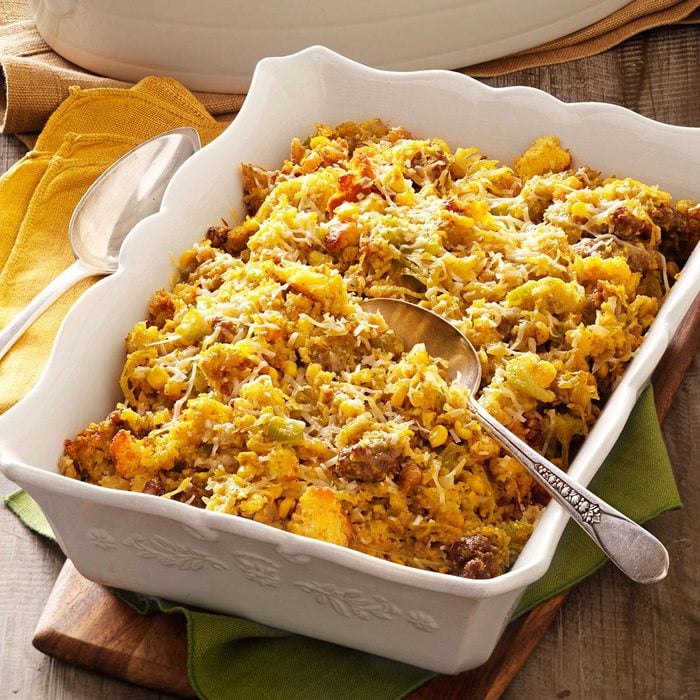ⓘ
You have an important decision to make this Thanksgiving: to stuff or not to stuff. Turkey stuffing is a traditional Thanksgiving recipe, and many say that dinner won’t turn out the same without it. Others claim stuffing isn’t safe, and the turkey becomes overcooked and dry by the time the stuffing reaches proper temperatures.
So what gives? Is there a way to safely stuff a turkey, or should you only make pan-roasted stuffing?
Should You Cook Stuffing Inside the Turkey?
The biggest issue with cooking stuffing inside the bird relates to temperatures. The United States Department of Agriculture (USDA) recommends cooking poultry until it reaches a safe internal temperature of 165°F. Anything cooked inside the turkey also needs to reach that temperature to prevent the risk of exposing you to bacteria like salmonella or E. coli.
But stuffing is soft and porous by nature. That’s the main reason to cook stuffing inside a turkey: The bread cubes soak up roasting turkey juices and transform into incredible-tasting flavor bombs. That means the stuffing needs to reach a safe temperature (165°) so it won’t make you sick.
The other important thing to consider with turkey stuffing is when it’s stuffed. Trying to prep in advance doesn’t work to your advantage here. Placing warm stuffing inside a refrigerated bird allows the stuffing to stay in danger zone temperatures for too long, causing bacteria growth. It’s okay to cook the vegetable component of the stuffing a day in advance and cool it down in the fridge. But wait to mix it with the bread and stuff the final product inside the bird until right before it goes into the oven.
How Does It Make Cooking the Turkey Different?
Cooking a stuffed turkey is a little different from an unstuffed turkey. Instead of only considering the meat’s temperature (165° in the thickest part of the breast and at least 170° in the thickest part of the thigh), you must also take the stuffing’s temperature.
Then there’s the timing of everything. The meat is on the outside of the bird, so it gets more exposure to heat. That means it cooks more quickly than the stuffing, which is enclosed deep within the bird’s cavity. By the time your stuffing reaches 165°, the meat can reach 180° or 185°—way past their ideal doneness temp. And cooking meat past its doneness temp = dry meat.
How to Stuff a Turkey
Our method cooks the turkey in a 325° oven. The low oven temperature ensures the turkey will be juicy and moist while the stuffing reaches a safe temperature.
When taking the turkey’s temperature, insert the probe into the thickest part of the breast or the thigh. Wiggle the probe to ensure it’s in the deepest part and isn’t touching the bone. For more turkey-cooking tips, check out our complete guide to how to cook a turkey.
Ingredients
- 1/2 cup butter
- 2 large onions, chopped
- 2 celery ribs, chopped
- 1/2 pound fresh mushrooms, sliced
- 1 can (14-1/2 ounces) chicken broth
- 1/3 cup minced fresh parsley
- 2 teaspoons rubbed sage
- 1 teaspoon salt
- 1 teaspoon poultry seasoning
- 1/2 teaspoon pepper
- 12 cups unseasoned stuffing cubes
- Warm water
- 1 turkey (14 to 16 pounds)
- Melted butter
Directions
- Preheat the oven to 325°F.
- Melt the butter in a large skillet over medium-high heat. Add the onions, celery and mushrooms and cook until tender, about 8 minutes. Remove the mixture from the heat and stir in the chicken broth, parsley, sage, salt, poultry seasoning and pepper. (You can make this part of the stuffing in advance, but do not combine it with the bread or stuff it inside the turkey until right before it goes into the oven.)
- Place the bread cubes in a large bowl and add the seasoned mushroom mixture. Toss to coat, adding enough warm water to reach the desired level of moistness.
- Just before baking, loosely stuff the turkey. If there is leftover stuffing, place it in a greased baking dish. Cover and refrigerate the dish until the turkey is almost finished. You’ll want to cook it covered for 30 to 40 minutes, and uncovered for an additional 10 minutes until it’s lightly browned.
- Skewer any turkey openings with toothpicks and tie the drumsticks together with butcher’s twine. Place the turkey breast side up on a rack in a roasting pan and brush it with melted butter.
- Bake the stuffed turkey, uncovered, for 3-3/4 to 4-1/2 hours, loosely covering the turkey with aluminum foil if it browns too quickly. When a thermometer reads 165° in the stuffing or 170° to 175° in the thigh, remove the turkey from the oven.
- Let the turkey stand for 20 minutes before carving the turkey. Remember to use the pan drippings to make foolproof gravy while you wait!
What to Stuff Your Turkey with Instead
If you decide to roast your turkey without stuffing, that doesn’t mean you have to leave that cavity space open. There are all kinds of things you can put in your turkey that aren’t stuffing to give your turkey more flavor.
Some of our favorites include quartered onions, orange segments, sliced lemons or apples, bundles of fresh herbs or chopped celery and fennel. These items take up significantly less space than stuffing, so they shouldn’t have any issues reaching safe temperatures by the time the bird is finished.
The Best Stuffing Recipes for Thanksgiving
Stuffing from the Slow CookerIf you're hosting a big Thanksgiving dinner this year, add this simple slow-cooked stuffing to your menu to ease entertaining. It cooks in just three hours and stays moist. Best of all, it doesn't use precious oven space.
Badger State StuffingThe contrasting sweet, savory and slightly tart flavors in this Thanksgiving classic are what make it so special. Bacon, fruit and sauerkraut give the stuffing a strong and memorable taste.
Sausage Bread DressingThis Italian sausage stuffing has some hidden sweetness. With apples and pecans, this must-have dish tastes just like fall.
Pecan-Cornbread DressingUsing cornbread stuffing mix cuts down on the time it takes to prep this smoky stuffing. Bacon and pecans give it a savory and sweet mix that'll perfectly complement your other Thanksgiving dishes.
Savory Zucchini Bread PuddingThis stuffing hits all the best flavor notes; savory, sweet and cheesy. Canned pumpkin and cinnamon work to make an aromatic and colorful dish.
Hearty Rice DressingThe creamy beef and pork dish packs just the right amount of heat. With 50 servings, you're going to want to invite everyone you know to dinner. Or cut the recipe in half!
Oyster StuffingBeef and pork stuffings are tried and true, but if you're looking to switch things up a bit this year, this is the recipe for you. Oyster lovers can leave them whole instead of chopping them up.
Smoked Sausage & Potato DressingThis dish has all the makings of smoky stuffing but with potatoes as the base instead of bread. If you have leftovers, top some with an over-easy egg for breakfast.
Slow Cooker Bacon-Mushroom DressingThis stuffing cooks in the slow cooker while the turkey's in the oven. It uses two types of prepackaged mix: cornbread and seasoned cubes.
Cheesy Bacon Ranch Potato StuffingNo gravy is required for this creamy mashed potato stuffing. This dressing is the combination of the two best Thanksgiving side dishes with some great add-ons like bacon and mushrooms.
Traditional Holiday StuffingYou can't beat the classics. Sausage and sage add a gourmet taste to this classic stuffing.
Special Herb DressingThis satisfying dressing has all the great tastes people crave. With meat, fresh herbs, earthy mushrooms, crunchy apples and a burst of tart cranberries, this large-serve stuffing is great for a potluck.
Moist Poultry DressingMushrooms and onions complement the big herb flavor in this stuffing. The slow cooker lends a hand to how it stays so moist.
Cranberry Pecan StuffingCranberries and pork really make this stuffing something special. The pecans add just the right amount of sweetness and crunch.
Wild Rice StuffingUse up your giblets in this buttery rice stuffing. It soaks up all the best flavors of your turkey and only bakes for 30 minutes.
Slow Cooker Mushroom StuffingPut your slow cooker to work! This herby mushroom stuffing is vegetarian for any guests that require it.
Southern Cornbread DressingThis southern dressing has hard boiled eggs and turkey giblets woven into it for a nice blended taste. It turns out moist, hearty and ready for more turkey.
“Everything” StuffingThis stuffing really does have it all. From the earthiness of the mushrooms to the sweetness of the apples, you get every flavor profile without overshadowing any of them.
Grandma’s Cornbread DressingThis creamy chicken-flavored dressing is pillow-soft. You can chop up your Thanksgiving meat of choice into the dish.
Amber’s Sourdough StuffingSourdough is a nice change of pace from your usual prepackaged stuffing mixes. The natural tang blends nicely with the mushrooms and celery. This stuffing is great for a small night in, or you can double it for a larger crowd.
Rice DressingThis mushroom and chicken flavored rice dressing is a nice change of pace from traditional bread stuffings. It stays moist and can soak up lots of flavor.
Cranberry Cornmeal DressingThis sweet and tart dressing is perfect when paired with poultry or even pork. The dried cranberries really complement the dish's turkey sausage.
Sausage and Cornbread DressingA little steak sauce goes a long way in this dressing. Cornbread and cubed bread add a savory burst of flavor.
Raisin-Studded Apple StuffingRaisins and tart apples adorn this satisfying sausage stuffing. With the soft bread and crisp apples, you'll forget about the other side dishes entirely.
Apple-Cranberry StuffingFruit and wild rice make this sweet and tart dressing just a bit earthy. You can use any type of apple, but Granny Smith yields great results.
Grandma’s Poultry DressingThis poultry dressing requires simple ingredients that you probably already have on hand. Relying on the pork sausage flavor, this hearty stuffing goes great with any turkey.
Cornbread Dressing with OystersThis hard-boiled egg and oyster dressing is not short on flavor. It cooks separately from the turkey, since
cooking stuffing inside the turkey can be dangerous.
Cornbread StuffingIf you're from the South, you might get the appeal of a hard-boiled egg stuffing. While other dressings have sausage, and even oysters, this one has chicken for a nice classic taste.
Fruit & Nut Andouille StuffingThis six-ingredient stuffing utilizes seasoned cubes. With mixed fruit and pork sausage, everything's thrown together really easily for a big flavor payout.
Bacon & Sausage StuffingWith bacon and sausage, this smoky stuffing doesn't lose any moisture. The bacon even adds a nice coloring to the dish.
Dried Cherry & Sausage DressingApples and dried cherries add a sweet-tart flavor to this Italian-seasoned stuffing. The texture of the cherries are similar to raisins, but they have a richer flavor.
Slow-Cooker DressingThis very simple dressing is made with ingredients you probably already have on hand. Use unseasoned cubes so you can season them to your liking. Once it’s in the slow cooker, you’re free to turn your attention to the other sides.
Herbed Apple-Cranberry Bread DressingApples give a nice crunch to this stuffing while applesauce and orange juice pack on the sweetness. This breadcrumb dressing is soft and takes in a lot of flavor.
Savory Sausage StuffingPork sausage can be a game changer to your usual stuffing recipe. This simple dressing uses two types of bread and dried cranberries for extra tartness.
Skillet Sausage StuffingThere's nothing easier than a skillet stuffing. The savory dish comes together in under a half hour which gives you more time to focus on your day. To make this sausage stuffing, you dress up a package of stuffing mix with pork sausage, mushrooms, celery and onion.
Sweet Potato StuffingSweet potatoes find their way to most Thanksgiving tables. This slow cooker dressing breathes new life into the starch. It's versatile and able to withstand adding your family's favorite ingredients to the mix.
Sausage-Herb DressingHave you ever heard of coffee in a stuffing? This slow cooker dressing has a deep and herby flavor that you won't be able to get enough of.
Make-Ahead Cornbread DressingThis dressing has a few surprising elements, the most notable being spaghetti squash. Spaghetti squash is great for a dressing because like rice, it takes to flavor really well. So with the added sausage, walnuts and cheese you end up with a delightfully rich and textured dish.
Mushroom StuffingA hearty cornbread mix combines with mushrooms and bacon for a spectacular result. This dressing is creamy and soft.
Apple & Apricot StuffingThis fruit and veggie stuffing is both sweet and tart. The apricots give it a nice orange coloring that will brighten your Thanksgiving table.






















